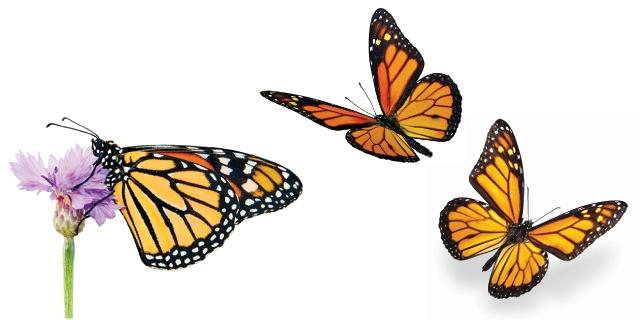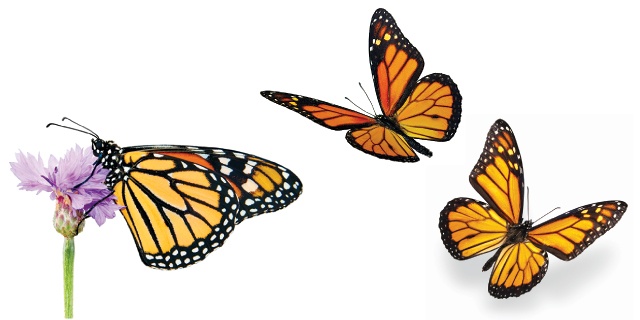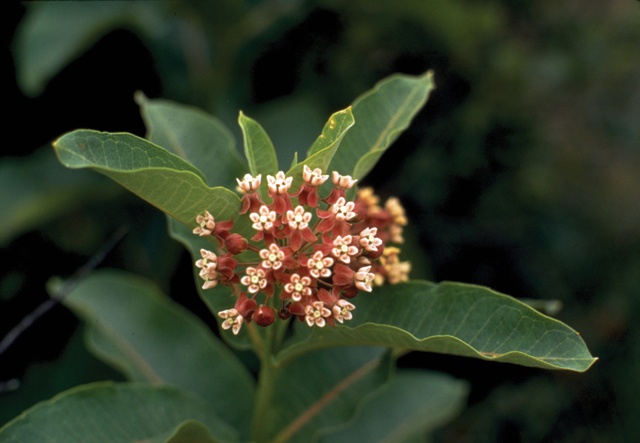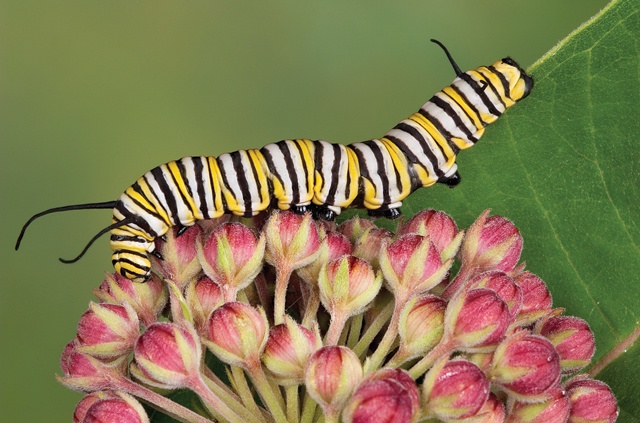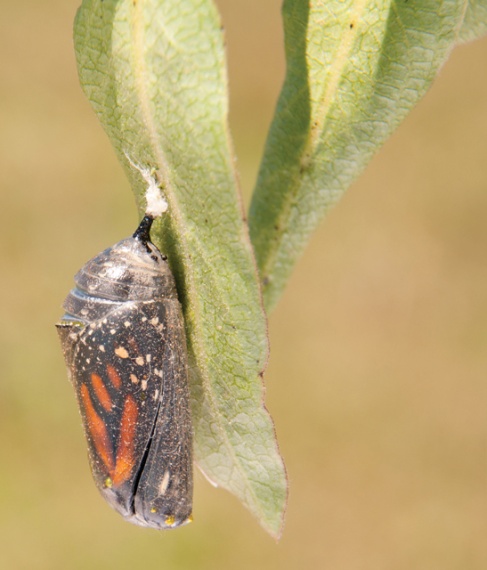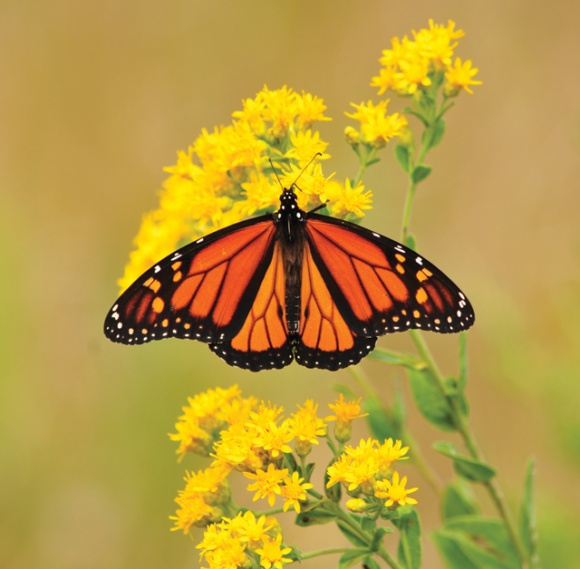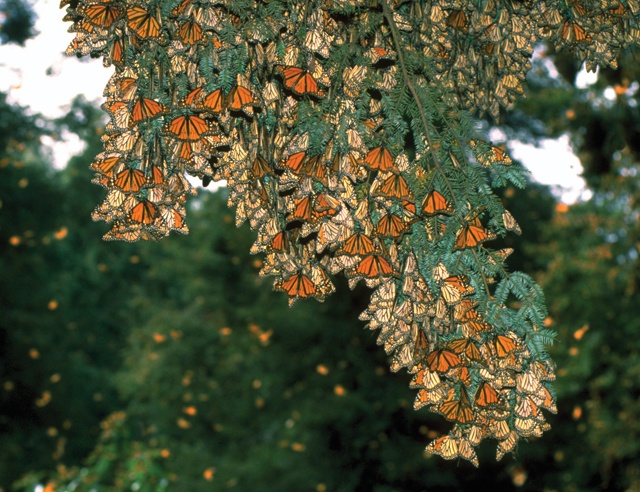After hanging on a back door frame in San Benito for 12 days, the pale jade-colored chrysalis had turned transparent, revealing streaks of black and orange. On a warm April morning, a monarch butterfly began to emerge. First, legs broke through the thin chrysalis and, in three long minutes, the monarch butterfly freed itself completely, although it clung to the remnants of the chrysalis.
For nine minutes, the butterfly pumped its crumpled wings, which slowly filled with fluid and straightened into the recognizable black-veined orange wings that resemble stained glass. Stepping from the wood frame to the brick wall, the monarch rested for more than four hours before flying off to feed on the nectar of nearby native plants: mistflower, lantana and scarlet sage.
If you think you have been seeing fewer monarchs, says Mike Quinn, who coordinates Monarch Watch in Texas and heads the Austin Butterfly Forum, you are right. “The monarch is not the rarest insect species, but it is the one people are most concerned about,” Quinn says. The monarch butterflies that spend summers between the Rockies and the Appalachian Mountains migrate through Texas twice a year. During September and October, the butterflies leave their summer breeding grounds in the northern Great Plains and southern Canada. The migratory pathway to their winter home in western Mexico carries them across Texas, where, like other travelers, they stop to eat. Favorite road foods include the nectar of purple coneflowers and black-eyed Susans.
In March the next year, the same monarchs that traveled south in the fall head north to Texas and adjoining states. After completing the longest round-trip insect migration known—up to 3,000 miles—they lay their eggs on milkweed plants. Those eggs hatch into caterpillars striped white, yellow and black after seven to 10 days. The caterpillars devour milkweed leaves and grow, shedding their skin five times over the next two weeks or so, and then form chrysalides. Once the butterflies emerge, like the one in San Benito, they head north for the summer.
But monarchs, Texas’ official state insect, have a problem: The 35 species of milkweed on which they lay eggs—and provide the only food source for the caterpillars—have become less abundant. The number of nectar plants the adults feed on also has decreased. Urban development in Texas annually takes out hundreds of thousands of acres that once hosted native plants like blazing stars and antelope horn milkweed.
Over the past three years, drought and high temperatures alternating with cold and rainy springs have limited monarch reproduction and survival because the butterfly’s life cycle is dependent on temperature. Flight and breeding occur when temperatures are between 60 and 90 degrees. When it is colder than average, each butterfly stage takes longer: Eggs can take 20 days to mature, and the development of caterpillars and chrysalides slows, too. That cuts the number of generations that reproduce and increase the population. When it is much drier or hotter than normal, butterflies appear to lay fewer eggs, and their range shrinks as their host and nectar plants dry up. Because 2012 was too hot at critical times and 2013 was too cold, the outcome was record low overwintering numbers in those years.
The average female monarch lays 400 eggs, one egg at a time, typically on the undersides of 400 leaves. The survival rate is about 1 percent, so ideally by season’s end each female that came to Texas in March could have 32 great-great-grandchildren flying back to Mexico, with all of them counting on a few dinners in Texas.
Last winter, observers estimated that only 33 million monarchs arrived in the oyamel fir forests of mountainous Michoacán, Mexico. In 1996, the monarch population there peaked at 1 billion. Yet, the butterflies have survived natural catastrophes (freezes in 2002 and 2004 killed up to 80 percent of the wintering population) and manmade ones, such as logging, which once threatened to destroy the winter retreat.
Disappearing Diet
North of Texas, the monarch population is having a much tougher time finding milkweeds. The 2007 Clean Energy Act, the ethanol mandate, caused corn and soybean prices to soar. As a result, approximately 24 million acres of upper Midwest grasslands and set-aside Conservation Reserve Program land have been converted to cropland. The disappearance of milkweeds and nectar plants from those acres is considered an additional blow for the emblematic butterfly.
“The monarch is iconic. Because it is so wide-ranging, it is the butterfly most Americans can relate to and identify,” says Marianna T. Wright, executive director of the National Butterfly Center, which covers 100 acres along the Rio Grande in Mission. “While the monarch is a hardy butterfly and won’t disappear, its migration is being affected. That appears to be linked to the disappearance of milkweed on their route.”
Chip Taylor, who heads Monarch Watch based at the University of Kansas, predicts the monarch population will continue to decline unless a massive restoration effort puts milkweeds back in the Great Plains habitat and halts further milkweed loss due to urban, suburban and rural expansions. Overall, he estimates that the area of lost milkweed/monarch habitat by 2013 amounted to one-third of the butterfly’s summer breeding range.
To counter these obstacles, numerous Texas groups and individuals—citizen scientists—have intervened to help monarchs on their journey. They observe migrating butterflies and report the data to organizations such as Monarch Watch, Journey North and the Monarch Larva Monitoring Project. (Migration flyways were “discovered” after citizen scientists began systematically reporting sightings.) They grow host and nectar plants at home and in public spaces. Some educate county and city officials about monarch-friendly policies for mowing and pesticide use. Taylor says citizen scientists are essential in re-establishing the monarchs’ host and nectar plants. “Habitat loss has been extreme, and we need everyone to pitch in,” he says.
The Native Plant Society of Texas started a Bring Back the Monarch program, which this year gave a total of $7,500 in grants to 38 groups to purchase host and nectar plants for demonstration gardens and monarch way stations. By encouraging habitat restoration, whether through a Texas Master Naturalists’ project in the Rio Grande Valley or at the Jasper Arboretum, the group is educating and involving the public.
“The monarch is a gorgeous butterfly that is speaking for all the other pollinators,” the less glamorous ones that also need host and nectar plants, says Kip Kiphart, a Texas master naturalist and retired cardiac surgeon. Kiphart has volunteered thousands of hours working with the larva monitoring project, training others and raising public awareness of the monarchs’ plight.
Although his spring monarch sightings at Cibolo Nature Center and around Boerne were scant, Kiphart was heartened by news of spectacular patches of antelope horn milkweed on the road to Guadalupe River State Park. “The amount of milkweed on farm-to-market roads this year is astounding,” he says.
The Lady Bird Johnson Wildflower Center lists Texas native seed farms and nurseries. Many regions have native plants groups and growers who know what works locally. In Junction, Bill Neiman and his family run Native American Seed Company, and he sees the demand for milkweed seed outstripping the farm’s production. “These are not domesticated plants,” he says. “We have to hand-harvest some of them, and we sell out every year.”
Climate and soil variations in Texas create 10 ecoregions, which host more than 35 varieties of milkweeds. Along with butterfly seed mixes, the farm’s catalog lists milkweeds, such as antelope horn (for drier upland areas), zizotes and butterfly weed for monarch caterpillars to munch on. Equally important are the shelter and nectar plant seeds: gay feather, Maximillian sunflower, ironweed, goldenrod and frostweed.
“Plant wildflower seeds in the fall,” Neiman advises, although the milkweed won’t sprout until spring. He regularly reminds his customers that the voracious caterpillars are going to strip their milkweeds bare. “Some people freak that bugs and caterpillars are eating their plants, and they kill the caterpillars,” he says. The chewed-up plants usually have new leaves within two weeks. Neiman recommends intentional neglect of individual plants, but not of the monarchs’ plight.
“If we’re not doing our part here, it doesn’t matter if they fix the other parts,” he says.
The Trip Home
Monarchs build up fat reserves on their migration south, Quinn explains. “You wouldn’t think a critter crossing a continent would gain weight, but they do. The monarchs take the least strenuous way home, riding tail winds and blue northers in the fall,” on a migration flyway that stretches west to Midland.
Monarchs generally do not spend the summer in Texas because milkweeds tend to dry up in the heat. But the Rio Grande Valley and the Houston/Coastal Bend area host monarchs year-round (as do areas of California and Florida). Here is where controversy rocks the butterfly garden: The easily propagated tropical or Mexican milkweed that is so popular with monarchs in the Valley and along the coast is not considered a native plant by some purists, although it is found in Mexico. This milkweed can carry a protozoa parasite that has killed butterflies in the chrysalis. While factions debate the wisdom of planting it, monarchs continue to use tropical milkweed.
Taylor says the spring reports in 2014 coincided with cool to moderate temperatures that favor population development. “Monarch numbers will rebound, but only if the weather allows and there is enough milkweed to increase the population,” he says. “Given the current size of the overwintering population, it is likely that it will take two to three years with relatively favorable breeding conditions for the population to regain its numbers.”
——————–
Eileen Mattei, a member of Nueces EC and Magic Valley EC, lives in Harlingen.
